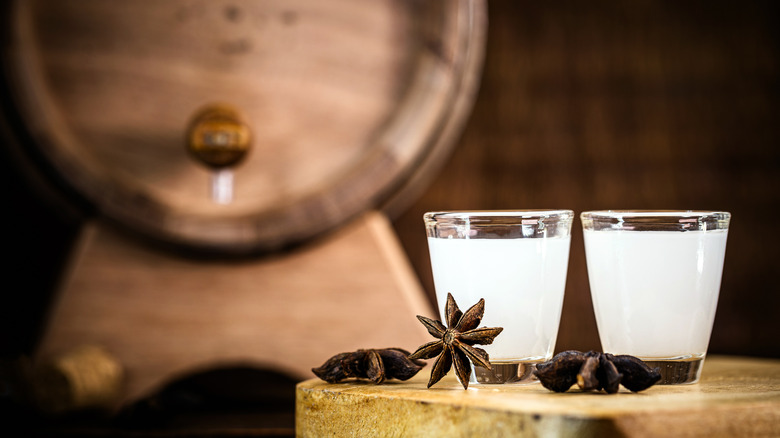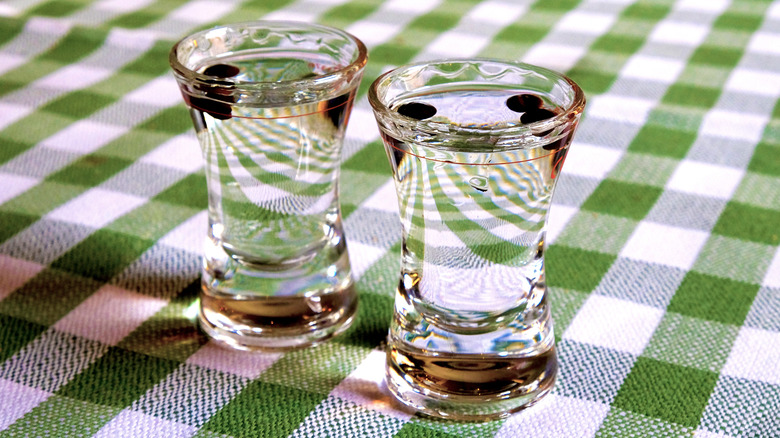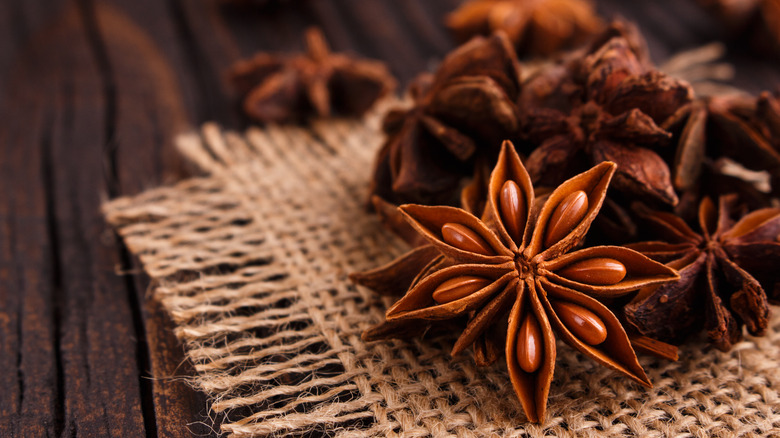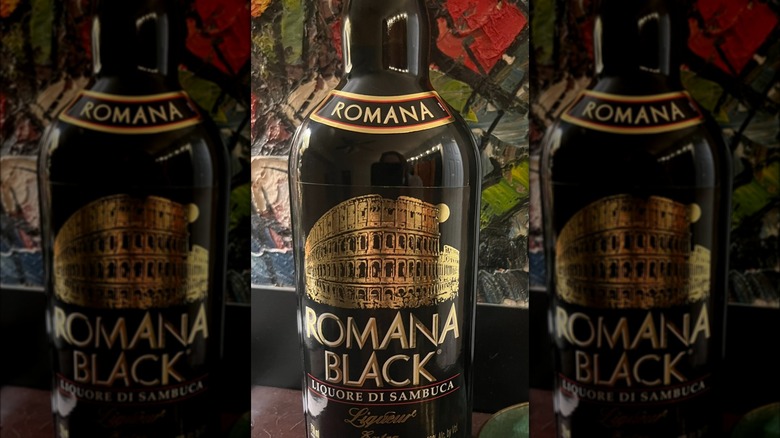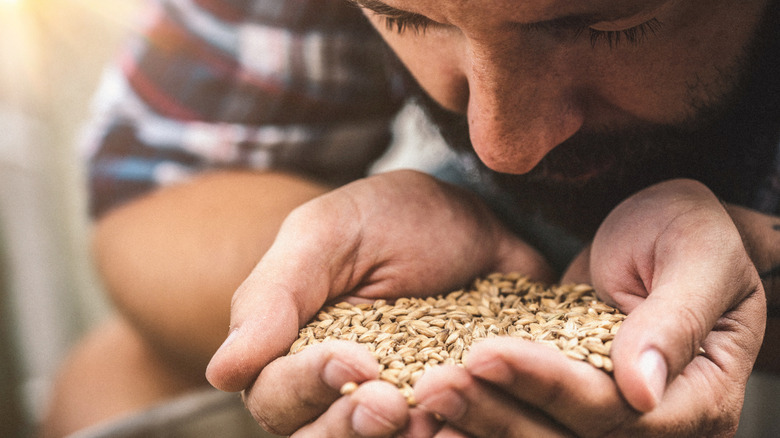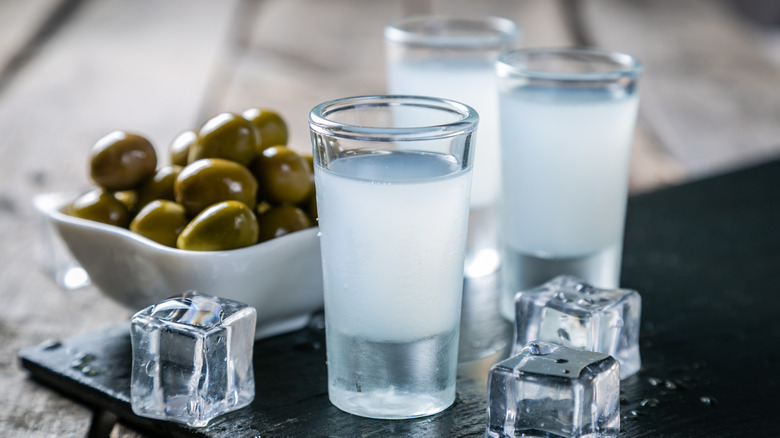Here's The Difference Between Ouzo And Sambuca
Ouzo and sambuca are more than just alcoholic beverages; the libations are gateways into the rich heritage and culture of their respective homelands. While both of the spirits are made with anise, which is a fragrant seed that lends a distinct licorice-like flavor, ouzo is from Greece and sambuca is from Italy. One of the major distinctions between ouzo and sambuca is when and how you drink each one.
Ouzo is an apéritif, which means that it's typically served pre-dinner, although in Greece the beverage is often accompanied by meze or appetizers. The spirit is commonly diluted with water and ice, a combination that gives it an appealing misty hue. In contrast, sambuca is a digestif, which means it's typically taken to help settle the stomach after a meal. The spirit is also sometimes served after coffee to dull its taste. These aren't the only aspects that set the two liquors apart. Here are the key differences between ouzo and sambuca that many people will probably find surprising!
What is ouzo?
Ouzo is a Greek apéritif with a very similar taste to black licorice, a sweet anise-flavored candy popular in the Netherlands. The liquor is also sometimes said to be fiery due to the force with which it hits the back of the palate. As such, ouzo is a beverage best sipped over ice with a little water rather than served as shots.
Dating back to the 19th century when the first ouzo distillery opened in Tirnavos in northeast Greece, over the years, ouzo has evolved into a beloved drink throughout Greece and beyond. The cultural icon has even earned the status of Greece's national spirit. Today, ouzo is typically served as an apéritif before meals. However, it's also commonly accompanied by a variety of meze (small dishes) such as feta cheese, olives, and grilled octopus. One of the most interesting aspects of ouzo is its cloudy appearance when mixed with water. Referred to as the "ouzo effect" or "louching," the phenomenon arises because the anise oil used to flavor the spirit isn't soluble in water.
What is sambuca?
Sambuca is a popular Italian liquor known for its sweet and anise-flavored profile. Sambuca has a relatively high sugar content, with 47 ounces of sugar per gallon. It's typically colorless, although there are variations with added colors or flavors, such as black and red sambuca. Aside from alcohol and sugar, the primary ingredient in sambuca is anise extract, a botanical derivative that gives the spirit its distinct licorice-like taste and aroma.
Sambuca is a digestif, which means that it's commonly drunk to soothe the stomach after meals. It's often enjoyed straight with three floating coffee beans. Those wishing to add an element of celebration to their sambuca experience sometimes also ignite the drink briefly before sipping, creating a mesmerizing blue flame that adds to its visual allure. In addition to being sipped neat, sambuca is also used as a key ingredient in various cocktails, where it adds a depth of flavor and a touch of sweetness.
Ouzo is the national drink of Greece
There's little doubt that ouzo is deeply ingrained in Greek tradition and culture. So much so that in 2006, the spirit was granted an EU-approved Protected Designation of Origin status. This means that liquor can only be produced and labeled as ouzo in Greece and Cyprus.
Ouzo has a long history. It's said that a version of the beverage called tsipouro was first distilled by Greek Orthodox monks of Mount Athos in the 14th century. Tsipouro, which is still popular in Greece, is a grappa made from grape pomace, or grape seeds and skin left over after the winemaking process. Although they share a similar flavor profile, the base spirit used in the production of ouzo has a higher alcohol content than that of tsipouro. This being said, it's unclear where the drink got its name. One belief is that it's derived from an old Greek word for smell (ózó). According to another theory, the word ouzo comes from the Turkish word for grape (ūzūm).
The first ouzo distillery was founded by Nicolas Katsaros in Tirnavos, Greece in 1856. Four generations later, the Katsaros distillery is still in existence and still produces anise-infused alcohol. The distillery's Jivaeri Ouzo is made from a blend of carefully selected herbs and spices, including anise, nutmeg, and finokio. Today, there are over 300 ouzo producers across Greece, with the area of Lesvos being particularly renowned for its production of the anise-flavored spirit.
Sambuca has roots in Italy
Sambuca's roots can be traced to 19th-century Italy. More specifically, the liquor's storied history began in 1851 in Civitavecchia, a port town 50 miles northeast of Rome, when Luigi Manzi came up with the first commercially sold sambuca. While some say that Manzi named his creation Sambuca Manzi to commemorate the "sambuchelli," or water and anise sellers of his hometown of Ischia, the story isn't entirely clear cut. According to other sources, the alcoholic beverage may have been named after the Latin word for elderberry (sambucus) or the Arabic word for an anise-flavored drink (zammut).
While sambuca gained in popularity among Italians at the beginning of the 20th century, it well and truly came into its own in the "La Dolce Vita" era of the 1950s and 1960s. Perhaps the most well-known sambuca brand is Molinari. Founded in 1945, over the years, the family-owned company has become a symbol of Italian craftsmanship and tradition. Even the legendary singer, Frank Sinatra, is said to have been so enamored with Molinari Sambuca that he praised the anise-infused spirit in a letter to the Molinari family.
Ouzo is white but turns cloudy when mixed with water
Ouzo offers a captivating drinking experience, drawing its appeal not only from the anise flavor, but also from its appearance. Looking at the clear spirit, the uninitiated may be forgiven for initially deeming it boring. It's ouzo's almost magical metamorphosis from a transparent liquid to a cloudy concoction when combined with water that's so fascinating.
According to a study by The Proceedings of the National Academy of Sciences, the so-called "ouzo effect" or "louching" takes place when anise oil comes in contact with water. This is due to the fact that oil dissolves well in alcohol but not in water. When water is combined with ouzo, and the alcohol content of the spirit falls below 30 proof, the oil ceases to bind to the alcohol. The tiny droplets of oil eventually fuse together, forming larger droplets that scatter light, thus turning the anise-flavored beverage opaque.
Sambuca comes in different colors
While at its most basic sambuca is also colorless like ouzo, unlike its cousin, the Italian spirit is also available in different colors. The different hues of sambuca are made from slightly different ingredients. Clear, or "white sambuca," is made with anise, licorice, and white elderflowers. In fact, just like ouzo, white sambuca can turn milky with the addition of water. However, not all sambuca types come with a sufficient concentration of anise oil to become cloudy.
Sambuca also comes in a dark version, often referred to as "black sambuca," which derives its color from elderberries and licorice. Black sambuca tends to be higher in alcohol content and not as sugary as other anisettes. Unlike, "white sambuca," which can be served in a variety of ways, "black sambuca" is typically taken neat in a snifter glass instead of a shot glass. Another sambuca type is "red sambuca," which gets its color and flavor from red elderberries.
Ouzo is made from grapes
Ouzo is made from grapes, or more specifically the remains of the grapes after the wine-making process. This pomace, which is usually composed of grape skins, stems, stalks, and seeds, is then distilled. To be labeled as such, ouzo has to be produced with at least 30% grape pomace. Other fruits, as well as cereals and potatoes, are also commonly used in ouzo's distillation process. Traditionally, ouzo is distilled in copper pot stills. In some very traditional facilities, the pots are still coated with bread dough. When the boiler heats up, this dough expands, sealing the pots.
Ouzo gains its unique flavor during the second distillation process when it's flavored with anise. The recipe for ouzo also commonly includes other botanicals and spices, such as fennel, cardamom, clove, cinnamon, coriander, and mint. However, this is up to the discretion of each distiller. According to Greek legislation, the final distillate is required to contain a minimum of 20% of the original ouzo yeast and must be at least 75 proof.
Sambuca is made from grain or molasses
Sambuca is crafted using an alcohol distillate as a base. Unlike ouzo, where this distillate is mostly made from grapes, Sambuca's distillate base is primarily made from grains and molasses. Sambuca comes to life during the flavoring process when the base alcohol is infused with star anise and sugar. Some other common ingredients that are used to balance out the liquor's flavor include elderflower, licorice, and fennel. The botanicals are typically added to the base alcohol in the form of essential oils.
To make sambuca, distillers combine demineralized water with sugar and heat this concoction to 150 degrees Fahrenheit. It's the large amount of sugar that gives sambuca its distinct sweet flavor. Afterward, the star anise is blanched and then crushed, enabling the extraction of its essential oils via steam distillation. After the ingredients are blended, they are left to rest in steel tanks for around a week. To be labeled as sambuca, the spirit has to be at least 76 proof.
Ouzo is an apéritif
Apéritifs are usually served before a meal to stimulate the appetite. They are meant to be enjoyed in small amounts and are designed to prepare the palate for the upcoming meal. In fact, the term "apéritif" has roots in the Latin word "aperire," which translates to "to open." The practice of enjoying an alcoholic beverage before a meal became popular in Europe — and especially Italy and later France — during the 19th century. As the café culture evolved, the tradition of enjoying a pre-dinner drink became an integral part of social gatherings in many European countries.
In Greece, many restaurants serve ouzo before the entrée. It's also often enjoyed alongside meze or small plates of appetizers such as feta, olives, sardines, meatballs, and cheeses. The anise-flavored spirit typically arrives at the table in small glasses and is meant to be sipped rather than chugged. Traditionally served at ouzeries, or ouzo bars, the liquor is supposed to be enjoyed in the company of friends throughout a leisurely afternoon, right up until dinner is served.
Sambuca is a digestif
Sambuca has a long history of being served as a post-meal digestif — or digestivi, as Italians would say, which is a beverage traditionally consumed to aid in the digestion of a meal. Centuries ago, digestifs were medical in nature. Made from herbs and other botanicals, they were prescribed for a huge range of ailments. It wasn't until the 18th century that digestifs started being served after heavy meals. Some of the world's best-known digestifs include brandy, Cognac, aquavit, and vermouth.
Digestifs usually feature a higher alcohol content than apéritifs, and 75-proof sambuca is no exception. And since sambuca contains anise, it's considered to be good for the stomach, with a list of benefits that includes not just settling the tummy, but also reducing flatulence and decreasing bloating. Aside from sambuca, Italy boasts an array of other digestifs, such as the zesty limoncello, the robust grappa, the aromatic mirto, the walnut-rich nocino, and the unique herbal blend of Galliano.
Ouzo is traditionally only served one way
If you're tempted to shoot ouzo, as you would another spirit, don't move a muscle! Ouzo was never meant to be knocked back party-style, nor was it meant to be used in cocktails. As far as good old-school tradition goes, there is only one way to savor this anise-flavored liquor — and that's without the addition of anything that could affect its very distinct flavor.
In Greece, ouzo is never served chilled or drank neat. Instead, the spirit usually arrives at the table with water and ice. Some ouzo aficionados claim that for the ultimate ouzo experience, one should first dilute it with water and then chill it with ice cubes. Notably, the process results in the "ouzo effect" or "louching" as the spirit suddenly turns cloudy. This is due to the interaction between the water and the anise oil in the ouzo, which is responsible for its distinctive licorice-like flavor.
Sambuca can be served in a variety of ways
When it comes to serving options and culinary creativity, sambuca is no one-trick pony. The anise-infused liquor can be served in a variety of ways. In Italy, it's frequently drunk as an "ammazzacaffè," a small glass of liquor after a meal and a coffee. The aim is to not just aid digestion but also dull the taste of the coffee. Sambuca can also be added to coffee as a replacement for sugar, "caffè corretto"-style. There's also the "sambuca con la mosca" or "sambuca with the fly," a shot glass of sambuca topped with three roasted coffee beans, which allegedly symbolize happiness, health, and prosperity (or the past, present, and future, depending on whom you ask).
Another classic — and visually appealing — way to serve sambuca is to set it on fire. The flaming sambuca involves briefly igniting the liquor to create a captivating blue flame atop the surface of the drink. Sambuca can also be mixed into cocktails, adding a unique anise flavor to your favorite alcoholic concoctions. For instance, the famous Italian sambuca brand, Molinari, features a recipe for the Sambucata, a zesty cocktail that combines sambuca, gin, white vermouth, orange and mandarin bitter, and essential oils of orange.
